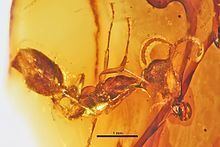Higher classification Ant Order Hymenopterans | Rank Subfamily | |
 | ||
Similar Ant, Brownimecia, Insect, Hymenopterans, Sphecomyrma | ||
Sphecomyrminae is an extinct subfamily of ants in family Formicidae known from a series of Cretaceous fossils found in North America, Europe, and Asia. Sphecomyrminae contains nine genera, divided into two tribes, Haidomyrmecini and Sphecomyrmini. The tribe Haidomyrmecini contains the four genera Ceratomyrmex, Haidomyrmex, Haidomyrmodes and Haidoterminus, while Sphecomyrmini contains Baikuris, Cretomyrma, Dlusskyidris, Sphecomyrma, and Zigrasimecia. The genus Sphecomyrmodes was formerly placed into Sphecomyrmini; however, in 2016, it was made a synonym of the stem group genus Gerontoformica, which is considered incertae sedis in Formicidae.
Contents
Sphecomyrminae is the most basal of the Formicidae subfamilies, but has not been included in several recent phylogenetic studies of the family. Symplesiomorphies of the subfamily include the structure of the antenna, which has a short basal segment and a flexible group of segments below the antenna tip. The petiole is low and rounded, with an unrestricted gaster and the presence of a metapleural gland. The subfamily is characterized by three major synapomorphies, the short pedicel, a second flagellar segment that is double the length of the other antenna segments, and the loss of the apical end of the CuA veins in the wings of adult males.
History and classification
The single Haidomyrmodes species, Haidomyrmodes mammathus, is known from fossil insects that are inclusions in transparent chunks of French amber. The genus was first described by paleoentomologists Vincent Perrichot and André Nel in 2008. The sister genus, Haidomyrmex, is more diverse with three described species, Haidomyrmex cerberus, Haidomyrmex scimitarus and Haidomyrmex zigrasi, all described from fossils in Burmese amber. While the type specimen of Haidomyrmex cerberus was collected in the early 1900s and deposited in the Natural History Museum in London, a description of the specimen did not occur until 1996 with a paper by the Russian paleoentomologist Gennady M. Dlussky. Both H. scimitarus and H. zigrasi were described in the same 2012 paper by Phillip Barden and David Grimaldi. The third genus, Haidoterminus, and its single species, Haidoterminus cippus, were described in 2013 from Canadian amber. This extended the age range for the tribe by an additional 20 million years into the Late Cretaceous and expanded the geographic range into North America.
In the sphecomyrmins, Baikuris is known from four species. Both B. mandibularis, and B. miriabilis were described in 1987 by Dlussky from a group of fossil males found in Taymyr amber while the third species, B. casei, was described in 1997 from New Jersey amber. A fourth species was described from Charentes amber as B. maximus. Both Cretomyrma species, C. arnoldii and C. unicornis are also described from Taymyr amber specimens, with their descriptions being published by Dlussky in 1975. In the same descriptive paper as Cretomyrma was another new monotypic genus, which Dlussky named "Palaeomyrmex"; however, this name was already preoccupied by Palaeomyrmex, which Oswald Heer described in 1865, and the Taymyr amber genus was given a new name, Dlusskyidris, in 1994 by B. Bolton. Fossils belonging to the subfamily were first discovered in exposures of the Santonian Magothy Formation at Cliffwood Beach, New Jersey in 1966. The fossils were described in 1967 by Edward O. Wilson and William L. Brown, who placed the new genus Sphecomyrma and species Sphecomyrma freyi into the new subfamily Sphecomyrminae. A second species of Sphecomyrma was described by Wilson in 1985 based on fossils found in Canadian amber from the Foremost Formation in Alberta. The third known species, S. mesaki was described in 2005 from New Jersey amber of the Raritan Formation.
The eighth genus of the subfamily, Zigrasimecia, was studied by Barden and Grimaldi with its description being published in 2013. The genus contains the type species Zigrasimecia tonsora, which is known from a solitary dealate female preserved in Burmese amber. While noting the close relationship between Zigrasimecia and Sphecomyrmodes, Barden and Grimaldi did not specifically place Zigrasimecia into any Sphecomyrminae tribe. In a later publication, Perrichot (2014) described the second species of Zigrasimecia, Z. ferox, and placed this genus in the tribe Sphecomyrmini.
